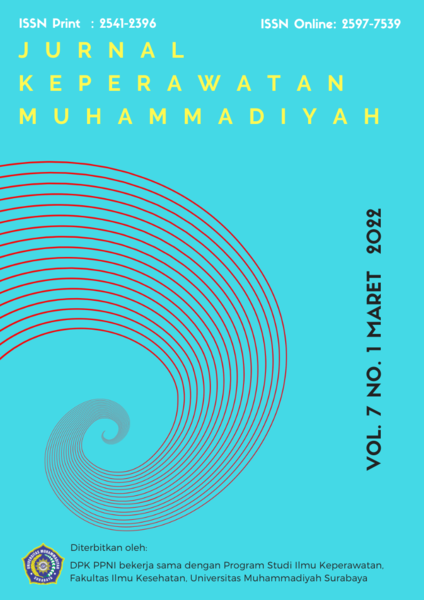Pengaruh Perubahan Legheel Alignment terhadap Lordosis Lumbal pada Penderita Overweight Di Komunitas Senam Aerobik Blukid Sidoarjo
DOI:
https://doi.org/10.30651/jkm.v7i1.10876Keywords:
Leg Hell Alignment, Lordosis Lumbal, OverweightAbstract
Objective: Â Â The foot has two main functions, first as the foundation of the body (base of support) and second as a lever in advancing the body when walking or running. The arch of the foot or arcus pedis is one of the most important parts that affect biomechanics and musculoskeletals in the feet (Ozdinc, et al., 2016). The presence of structural and functional abnormalities in the feet can cause posture abnormalities in the legs, based on the structure of foot posture is divided into three types, namely normal arch, low arch / flat and high arch / cavus. (Mootaah et al,2014)
Methods: This study using non-parametric statistical methods is a statistical method that can be used by ignoring assumptions that underlie the use of study results of treatment of leg hell alignment respondents obtained a value of p 0.00 (p < 0.05), which shows statistically the Effect of Leg heel Alignment Changes On Lumbar Lordosis In Overweight Sufferers In The Aerobic Gymnastics Community Blukid Sidoarjo
Results: Â Â With the change in the angle of leg hell alignment, it also affects the change in the angle of lumbar lordosis in aerobic gymnastics respondents in Bluru Kidul Sidoarjo.
Â
Conclusion: With the provision of insole and aerobic gymnastics is expected to be a solution related to handling if there are symptoms due to hyperlordosis from lumbar, especially in overweight sufferers, by also paying attention to the condition of leg heel alignment.References
Anand, Heggannavar et al. 2016. A correlation between leg-heel alignment, tibial torsion and q angle amongst normal, overweight and obese individuals. Int J Physiother Res, Vol 4(3); page-1531.
Ariani, L dan Ari Wibawa, I. M. 2014. Aplikasi Heel Raises Exercise Dapat Meningkatkan Lengkungan Kaki dan Keseimbangan Statis pada Anak Flat Foot Usia 4-5 Tahun di TK Aisyiyah Bustanul Athfal 3 Denpasar, 3-4.
Hillstrom, J. et al. 2013. Foot Type Biomechanichs part I : Structure and Funcion of The Asymptomatic Foot. Gait Posture, 446-458.
Kementrian Kesehatan Republik Indonesia. Riset Kesehatan Dasar Tahun 2013. Departemen Kesehatan Republik Indonesia.2013.
Laporan Nasional Riset Kesehatan Dasar (Riskesdas) Tahun 2007.Balitbangkes.2007;54–5.
Lardner, R. et al. 2010. Assessment and Treatment of Muscle Imbalance : The Janda Approach.Phillipina: Human Kinetics.
Little, T. 2015. The Effect of Experimental Knee Pain on Contralateral Quadriceps Strength and Thigh Muscle Activity.(Thesis). Unitec Institute Of Technology.
Lowth, M. (2015, April 24). Dipetik Februari 16, 2018, dari Flat Feet Article Online: https://patient.info/health/heel-and-foot-pain-plantar-fasciitis/flatfeet
Mosca, V. 2010.Flexible Flat foot in Children and Adolescents. (4).
Musculosceletal Rehabilitation Clinic. (2016, Juni 23). Flet Feet (Kaki Datar). Dipetik Februari 19, 2018, dari Flet Feet (Kaki Datar): http://www.flexfreeclinic.com/detail-artikelx/88-Flat-Feet-(Kaki-Datar)
Ozdinc, A. danTuranz, N. 2016.Effect of Ballet Training of Children in Turkey on Foot Antropometric Measurements and Medial Longitudinal Arc Development .J Pak Med Assoc.
Pita-Fernández, S. et al. 2015.Validity of Footprint Analysis to Determine Flatfoot Using ClinicalDiagnosis as the Gold Standard in a Random Sample Aged 40 Years and Older. J Epidemiol 2015;25(2):148-154
Sahabuddin, H. 2016. Hubungan Antara Flat Foot Dengan Keseimbangan Dinamis Pada Murid TK Sulawesi. Makassar: Prodi S1 Fisioterapi, Fakultas Kedokteran, Universitas Hasanuddin.
WHO.Global Status Report on Noncommunicable Diseases. 2014.
Downloads
Published
Issue
Section
License
- Penulis tetap memegang hak atas karyanya dan memberikan hak publikasi pertama kepada jurnal ini yang secara simultan karya tersebut dilisensikan di bawah:Â Creative Commons Attribution-ShareAlike 4.0 International (CC BY-SA 4.0)













